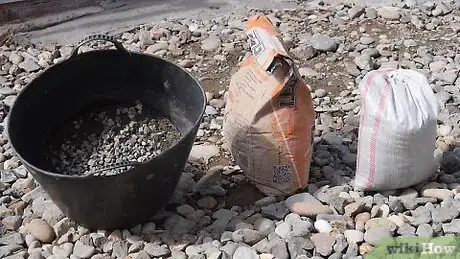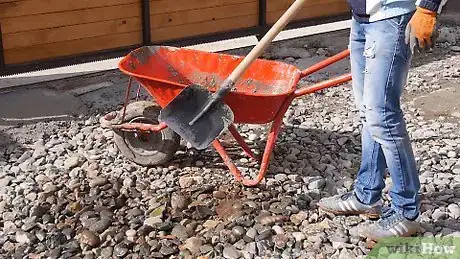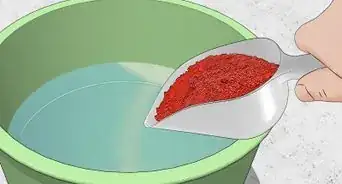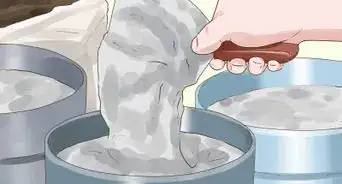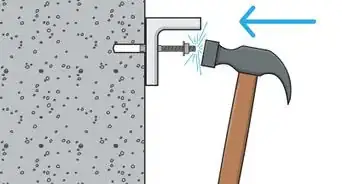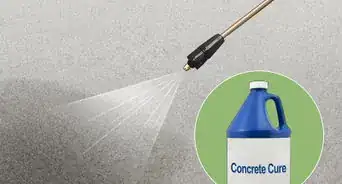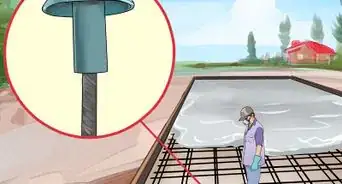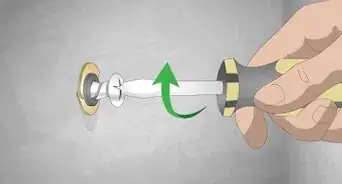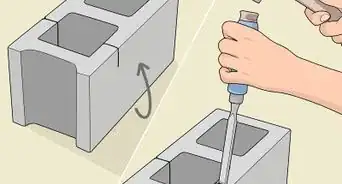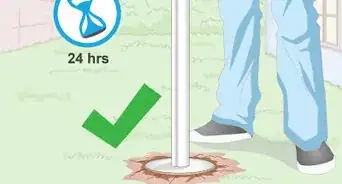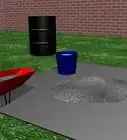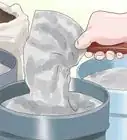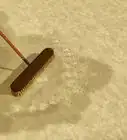This article was co-authored by Gerber Ortiz-Vega. Gerber Ortiz-Vega is a Masonry Specialist and the Founder of GO Masonry LLC, a masonry company based in Northern Virginia. Gerber specializes in providing brick and stone laying services, concrete installations, and masonry repairs. Gerber has over four years of experience running GO Masonry and over ten years of general masonry work experience. He earned a BA in Marketing from the University of Mary Washington in 2017.
wikiHow marks an article as reader-approved once it receives enough positive feedback. In this case, 83% of readers who voted found the article helpful, earning it our reader-approved status.
This article has been viewed 621,982 times.
Whenever a project calls for a hard, permanent binding material, most professional and independent builders use cement. Before using cement, you need to mix it with sand and stone. While this process can seem overwhelming, it's fairly simple with the right tools. You can mix your cement in a wheelbarrow using a spade or shovel before applying it to the area you're paving.
Steps
Preparing the Dry Mix
-
1Purchase the right amounts of cement, sand, and stone. The precise ratios will vary depending on the type of cement, so make sure to check your bag or the instructions that came with your cement. However, as a general rule of thumb, you will need one part cement, two parts sand, and four parts stone.[1]
- Always follow the instructions that came with the cement since adding too much sand, gravel, or cement can cause the concrete to break.[2]
-
2Put on safety equipment. Cement will admit dust and debris that can be dangerous without the right safety equipment. Wear a dust mask, as well as safety glasses and long jeans.[3] You should also wear a thick pair of gloves when mixing cement.[4]Advertisement
-
3Assemble your supplies. Mixing cement is a messy process that requires a lot of attention. Assemble your supplies ahead of time. You will need your cement, sand, and stone, as well as a bucket, a wheelbarrow, and a shovel or similar tool for mixing[5]
-
4Dump your ingredients into a wheelbarrow. Use your small spade to shovel a ratio of one part cement, two parts sand, and four parts gravel into the wheelbarrow. Make sure you're wearing your dust mask, as dust and debris will get into the air during the process.[6]
- To prevent the cement from drying out before you use it, don’t mix more than half a wheelbarrow at a time. Once you’ve used it up, you can create another batch.
-
5Mix the ingredients together. Though they'll be mixed later, it's a good idea to have the dry mix thoroughly incorporated before adding the water. After pouring your cement, sand, and stone into the wheelbarrow, use a shovel or similar tool to mix the ingredients together until you have an even, uniform mixture.[7]
Mixing in Water
-
1Make a crater in the pile of cement. Use your shovel to dig a small crater in the center of your cement mixture. The crater should be about half the diameter of the pile. When you're done, your pile should resemble a volcano.[8]
-
2Add a small amount of water. There is no precise amount of water to add to your cement. You merely need to add enough that you form a smooth paste with the consistency of peanut butter. Start small to avoid creating cement that's too soupy. Pour a small amount of water, like half a bucket, into the crater you made. Then, mix in the water with your shovel until it's completely absorbed.[9]
- If you're using the cement for something that will have a concrete finish, 3 parts concrete to 1 part water is usually best. If you're using the cement for a concrete foundation, it's OK if you use more water since the finish won't matter.[10]
-
3Test the mixture. Drag a shovel through the center of the cement. If the mixture is too dry, the sides of the groove you created will crumble. This means the mixture needs more water.[11]
Completing the Process
-
1Adjust the mixture as necessary. It will take some trial and error to get the right consistency. Add water a little at a time until you have a firm, spreadable paste. If you accidentally get the paste too wet, to the point the cement is soupy, add a little more of the dry mixture to fix this issue.[12]
-
2Pour the mixed cement immediately into your project's area. This step needs to be completed as soon as possible. This prevents the cement from drying before you can complete your project. Tilt the wheelbarrow over the area where you're applying cement and pour the cement mixture in.
-
3Clean up your supplies as soon as possible. That way the cement won't dry on anything.[13] Pour water into the wheelbarrow as soon as you empty out the cement. Submerge your tools in the wheelbarrow. Then, scrub the wheelbarrow and tools with a stiff-bristle brush until it has been completely freed of any cement.[14]
Expert Q&A
Did you know you can get expert answers for this article?
Unlock expert answers by supporting wikiHow
-
QuestionWhat is the ratio for cement mix?
 Gerber Ortiz-VegaGerber Ortiz-Vega is a Masonry Specialist and the Founder of GO Masonry LLC, a masonry company based in Northern Virginia. Gerber specializes in providing brick and stone laying services, concrete installations, and masonry repairs. Gerber has over four years of experience running GO Masonry and over ten years of general masonry work experience. He earned a BA in Marketing from the University of Mary Washington in 2017.
Gerber Ortiz-VegaGerber Ortiz-Vega is a Masonry Specialist and the Founder of GO Masonry LLC, a masonry company based in Northern Virginia. Gerber specializes in providing brick and stone laying services, concrete installations, and masonry repairs. Gerber has over four years of experience running GO Masonry and over ten years of general masonry work experience. He earned a BA in Marketing from the University of Mary Washington in 2017.
Masonry Specialist & Founder, GO Masonry LLC It depends on the application. If you're going to do something with a concrete finish, you'll generally use three parts concrete and one part water. When you're mixing and pouring the concrete, you’re gonna have to add more water or it's not going to mix properly. If you're doing a concrete foundation for a retaining wall or a post, the concrete can be more wet because the finish is not going to matter.
It depends on the application. If you're going to do something with a concrete finish, you'll generally use three parts concrete and one part water. When you're mixing and pouring the concrete, you’re gonna have to add more water or it's not going to mix properly. If you're doing a concrete foundation for a retaining wall or a post, the concrete can be more wet because the finish is not going to matter. -
QuestionHow do you keep concrete from sticking to tools?
 Gerber Ortiz-VegaGerber Ortiz-Vega is a Masonry Specialist and the Founder of GO Masonry LLC, a masonry company based in Northern Virginia. Gerber specializes in providing brick and stone laying services, concrete installations, and masonry repairs. Gerber has over four years of experience running GO Masonry and over ten years of general masonry work experience. He earned a BA in Marketing from the University of Mary Washington in 2017.
Gerber Ortiz-VegaGerber Ortiz-Vega is a Masonry Specialist and the Founder of GO Masonry LLC, a masonry company based in Northern Virginia. Gerber specializes in providing brick and stone laying services, concrete installations, and masonry repairs. Gerber has over four years of experience running GO Masonry and over ten years of general masonry work experience. He earned a BA in Marketing from the University of Mary Washington in 2017.
Masonry Specialist & Founder, GO Masonry LLC
-
QuestionWhat safety precautions should be taken when mixing and placing concrete?
 Gerber Ortiz-VegaGerber Ortiz-Vega is a Masonry Specialist and the Founder of GO Masonry LLC, a masonry company based in Northern Virginia. Gerber specializes in providing brick and stone laying services, concrete installations, and masonry repairs. Gerber has over four years of experience running GO Masonry and over ten years of general masonry work experience. He earned a BA in Marketing from the University of Mary Washington in 2017.
Gerber Ortiz-VegaGerber Ortiz-Vega is a Masonry Specialist and the Founder of GO Masonry LLC, a masonry company based in Northern Virginia. Gerber specializes in providing brick and stone laying services, concrete installations, and masonry repairs. Gerber has over four years of experience running GO Masonry and over ten years of general masonry work experience. He earned a BA in Marketing from the University of Mary Washington in 2017.
Masonry Specialist & Founder, GO Masonry LLC
Things You'll Need
- Protective gear
- Heavy-duty wheelbarrow
- Cement mix
- Sand
- Stone
- Water source
- Small shovel or spade
References
- ↑ https://dengarden.com/home-improvement/Mixing-Concrete-by-Hand
- ↑ Gerber Ortiz-Vega. Masonry Specialist & Founder, GO Masonry LLC. Expert Interview. 10 March 2020.
- ↑ Gerber Ortiz-Vega. Masonry Specialist & Founder, GO Masonry LLC. Expert Interview. 10 March 2020.
- ↑ https://www.familyhandyman.com/masonry/pouring-concrete/how-to-properly-mix-concrete/view-all
- ↑ https://www.familyhandyman.com/masonry/pouring-concrete/how-to-properly-mix-concrete/view-all
- ↑ https://dengarden.com/home-improvement/Mixing-Concrete-by-Hand
- ↑ https://www.hunker.com/12500027/how-to-mix-portland-cement-with-sand
- ↑ https://dengarden.com/home-improvement/Mixing-Concrete-by-Hand
- ↑ https://www.familyhandyman.com/masonry/pouring-concrete/how-to-properly-mix-concrete/view-all
- ↑ Gerber Ortiz-Vega. Masonry Specialist & Founder, GO Masonry LLC. Expert Interview. 10 March 2020.
- ↑ https://www.familyhandyman.com/masonry/pouring-concrete/how-to-properly-mix-concrete/view-all
- ↑ https://www.familyhandyman.com/masonry/pouring-concrete/how-to-properly-mix-concrete/view-all
- ↑ Gerber Ortiz-Vega. Masonry Specialist & Founder, GO Masonry LLC. Expert Interview. 10 March 2020.
- ↑ https://www.familyhandyman.com/masonry/pouring-concrete/how-to-properly-mix-concrete/view-all
About This Article
To mix cement, start by combining 1 part cement, 2 parts sand, and 4 parts gravel in a large bucket or wheelbarrow. Next, make a small crater in this mixture and add half a bucket of water. Mix the cement with a shovel and add more water until it’s formed a smooth paste similar to peanut butter. Then, use the cement for your project and clean your supplies as soon as possible so the cement doesn’t dry on your tools. For tips from our Home Improvement reviewer on what to do if your cement turns out too soupy, read on!
